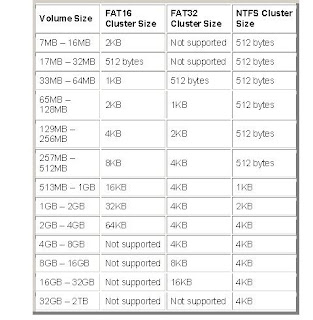 The FAT contains an entry for every file stored on the volume that contains the address of the file's starting cluster. Each cluster contains a pointer to the next cluster in the file, or an end-of-file indicator at (0xFFFF), which indicates that this cluster is the end of the file. The diagram shows three files: File1.txt uses three clusters, File2.txt is a fragmented file that requires three clusters and File3.txt fits in one cluster. In each case, the file allocation table entry points to the first cluster of the file.
The FAT contains an entry for every file stored on the volume that contains the address of the file's starting cluster. Each cluster contains a pointer to the next cluster in the file, or an end-of-file indicator at (0xFFFF), which indicates that this cluster is the end of the file. The diagram shows three files: File1.txt uses three clusters, File2.txt is a fragmented file that requires three clusters and File3.txt fits in one cluster. In each case, the file allocation table entry points to the first cluster of the file.The first incarnation of FAT was known as FAT12, which supported a maximum partition size of 8MB. This was superseded in 1984 by FAT16, which increased the maximum partition size to 2GB. FAT16 has undergone a number of minor modifications over the years, for example, enabling it to handle file names longer than the original limitation of 8.3 characters. FAT16's principal limitation is that it imposes a fixed maximum number of clusters per partition, meaning that the bigger the hard disk, the bigger the cluster size and the more unusable space on the drive. The biggest advantage of FAT16 is that it is compatible across a wide variety of operating systems, including Windows 95/98/Me, OS/2, Linux and some versions of UNIX.
Dating from the Windows 95 OEM Service Release 2 (OSR2), Windows has supported both FAT16 and FAT32. The latter is little more than an extension of the original FAT16 file system that provides for a much larger number of clusters per partition. As such, it offers greatly improved disk utilisation over FAT16. However, FAT32 shares all of the other limitations of FAT16 plus the additional one that many non-Windows operating systems that are FAT16-compatible will not work with FAT32. This makes FAT32 inappropriate for dual-boot environments, although while other operating systems such as Windows NT can't directly read a FAT32 partition, they can read it across the network. It's no problem, therefore, to share information stored on a FAT32 partition with other computers on a network that are running older versions of Windows.
With the advent of Windows XP in October 2001, support was extended to include the NTFS. NTFS is a completely different file system from FAT that was introduced with first version of Windows NT in 1993. Designed to address many of FAT's deficiencies, it provides for greatly increased privacy and security. The Home edition of Windows XP allows users to keep their information private to themselves, while the Professional version supports access control and encryption of individual files and folders. The file system is inherently more resilient than FAT, being less likely to suffer damage in the event of a system crash and it being more likely that any damage is recoverable via the chkdsk.exe utility. NTFS also journalises all file changes, so as to allow the system to be rolled back to an earlier, working state in the event of some catastrophic problem rendering the system inoperable.
FAT16, FAT32 and NTFS each use different cluster sizes depending on the size of the volume, and each file system has a maximum number of clusters it can support. The smaller the cluster size, the more efficiently a disk stores information because unused space within a cluster cannot be used by other files; the more clusters supported, the larger the volumes or partitions that can be created.


No comments:
Post a Comment